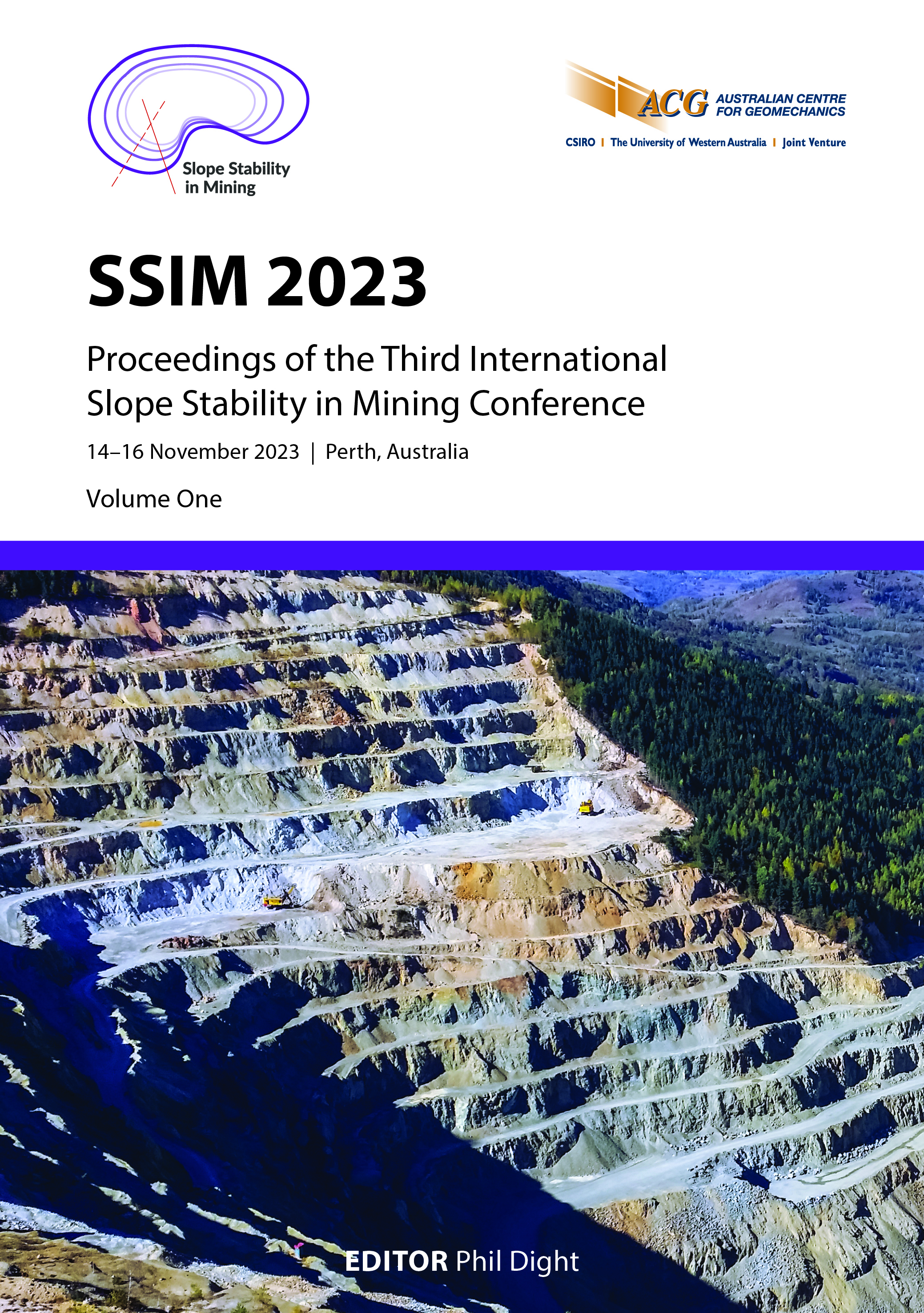Geotechnical design considerations for ‘nose’ geometries in pit design

|
Authors: Huaman, A |
DOI https://doi.org/10.36487/ACG_repo/2335_10
Cite As:
Huaman, A 2023, 'Geotechnical design considerations for ‘nose’ geometries in pit design', in PM Dight (ed.), SSIM 2023: Third International Slope Stability in Mining Conference, Australian Centre for Geomechanics, Perth, pp. 201-214, https://doi.org/10.36487/ACG_repo/2335_10
Abstract:
Convex geometries in open pits, also known as ‘nose’ or ‘bullnose’ slopes, are generally considered sectors with high potential to develop sliding instabilities. Despite this, within the current state of practice, design considerations for these sectors are scarce or limited to certain types of rock mass conditions. Practical experience has shown that the performance of this type of slope geometry heavily relies on the effects of stress redistribution given the slope convexity, the competency of the rock being excavated, the presence of major and minor geological structures as well as operational factors that may include blasting damage. In this light, this paper reviews the technical literature pertaining to geotechnical design considerations for convex and concave slope geometries and presents examples where the effect of deconfinement and the influence of lateral stresses are evaluated through three-dimensional numerical modelling. The effect of convexity (plan curvature) on slope stability is analysed by evaluating ‘nose’ geometries assuming idealised slope geometries and isotropic homogeneous rock masses with low to medium geotechnical quality.
Keywords: nose geometry, bullnose, convex slope, lateral stress, deconfinement
References:
Azocar, K & Hazzard, J 2015, ‘The influence of curvature on the stability of rock slopes’, Proceedings of the 13th International ISRM Congress 2015.
Bye, AR & Bell FG 2001, ‘Stability assessment and slope design at Sandsloot open pit, South Africa’, International Journal of Rock Mechanics & Mining Sciences, no. 38, pp. 449–466.
Cala, M 2007, ‘Convex and concave slope stability analysis with numerical methods’, Archives of Mining Sciences, vol. 52, no. 1, pp. 75–89.
Dawson, EM, Roth, WH & Drescher, A 1999, ‘Slope stability analysis by strength reduction’, Géotechnique, vol. 49, no. 6,
pp. 835–840.
Gomez, P, Diaz, M & Lorig, L 2002, ‘Stability analysis of waste dumps at Chuquicamata mine’, Felsbau Rock Mechanics Journal.
/learning/hoeks-corner/lecture-series.
Hoek, E, Hutchinson, J, Kalenchuk, K & Diederichs, M 2009, ‘Influence of in situ stresses on open pit design’, ‘Appendix 3’, Guidelines for Open Pit Slope Design Read and Stacey, 1st edn, CRC Press, Boca Raton.
Hoek, E & Bray, J 1981, Rock Slope Engineering, 3rd edn, Institution of Mining and Metallurgy, London.
Hoek, E, Carranza-Torres, C & Corkum, B 2002, ‘Hoek–Brown failure criterion—2002 edition’, Proceedings of the North American Rock Mechanics Society Meeting, pp. 267–273.
Karzulovic, A 2004, ‘The importance of rock slope engineering in open pit mining business optimization’, in WA Lacerda, ME Ehrlich, SAB Fontoura & ASF Sayão (eds), Proceedings of the Ninth International Symposium on Landslides, CRC Press, Boca Raton.
Kayesa, G 2006, ‘Prediction of slope failure at Letlhakane Mine with the GeoMoS Slope Monitoring System’, Proceedings of the International Symposium on Stability of Rock Slopes in Open Pit Mining and Civil Engineering Situations, Symposium Series S44, The South African Institute of Mining and Metallurgy, Johannesburg, pp. 605–622.
Long, A, Merril, R, Wiseccarver, D 1966, Stability of High Road Bank Slopes in Rock – Some Design Concepts and Tools, Highway Research Record, No. 135, pp 10-26.
Lorig, L & Varona, P 2007, ‘Numerical analysis’, in C Wyllie & CW Mah (eds), Rock Slope Engineering, Civil and Mining, 4th edn, Spon Press, London.
Narendranathan, S, Thomas, RDH & Neilsen, JM 2013, ‘The effect of slope curvature in rock mass shear strength derivations for stability modelling of foliated rock masses’, in PM Dight (ed.), Slope Stability 2013: Proceedings of the 2013 International Symposium on Slope Stability in Open Pit Mining and Civil Engineering, Australian Centre for Geomechanics, Perth,
Piteau, D & Jennings, J 1970, ‘The effects of plan geometry on the stability of natural slopes in rock in the Kimberley area of South Africa’, Proceedings of the 2nd Congress of the International Society of Rock Mechanics, vol. 3, paper 7-4.
Piteau, D 1974, Plan Geometry and Other Factors Relating to Natural Rock Slope Stability Applied to Design of De Beers mine, Technical Bulletin TB 190, Department of Energy, Mines and Resources Mines Branck, Ottawa.
Read, J & Stacey, P 2009, Guidelines for Open Pit Slope Design, 1st edn Leiden, CRC Press, Boca Raton.
Rocscience 2023a, 3D Geotechnical Finite Element Analysis RS3 User’s Guide, version, 4.028, Rocscience, Canada.
Rocscience 2023b, 2D Geotechnical Finite Element Analysis RS3 User’s Guide, version, 2.028, Rocscience, Canada.
Rose, N, Scholz, M, Burden, J, King, M, Maggs, C & Havaej, M 2018, ‘Quantifying transitional rock mass disturbance in open pit slopes related to mining excavation, Proceedings of Slope Stability 2018.
Sjoberg, J 1997, Estimating Rock Mass Strength Using the Hoek-Brown Failure Criterion and Rock Mass Classification, internal report, Division of Rock Mechanics, Luleå University of Technology, Luleå.
Wines, D 2015, ‘A comparison of slope stability analyses in two and three dimensions’, Proceedings of Slope Stability 2015, The Southern African Institute of Mining and Metallurgy, Johannesburg.
Xing, Z 1988, ‘Three-dimensional stability analysis of concave slopes in plan view’, Journal of Geotechnical Engineering, vol. 114, pp. 658–671.
© Copyright 2025, Australian Centre for Geomechanics (ACG), The University of Western Australia. All rights reserved.
View copyright/legal information
Please direct any queries or error reports to repository-acg@uwa.edu.au
View copyright/legal information
Please direct any queries or error reports to repository-acg@uwa.edu.au

